
Would you like to start a conversation with other industry leaders to brainstorm a challenge or to just know more on a particular topic?
Engage in online discussions with your Peers
Start NowDigital is no longer just a talking point. Digital is currently dominating most C-suite and boardroom agendas. Organizations of all sizes are implementing programs that promise to transform the customer experience and streamline business operations. Just staying abreast of developments in technology is no longer enough. Emerging technologies such as blockchain along with innovative business models are transforming life, business and the global economy at a speed none of us have ever seen before. As a result, the way we’ve been used to doing things isn’t just being modified; it’s being replaced and disrupted to drive profound, positive change.
Organizations need to get radical with blockchain and get started to leverage its capabilities i.e. distributed ledger, the power of smart contracts, transaction immutability, challenge the existing assumptions of core businesses and commit to strategies that promise rapid growth. Blockchain could dramatically simplify market infrastructures, reduce the need for intermediaries and, therefore, increase operational efficiency. It is just a matter of setting up the right conditions to make it possible, as it is not just a means to improve existing organizations and processes, but a brand-new way of considering them.
SSOs – The Natural Fit
Large organizations have begun experimenting with blockchain in various areas relevant to their industry verticals and some are forming a blockchain consortium with fellow industry heavyweights.
Blockchain could dramatically simplify market infrastructures, reduce the
need for intermediaries and, therefore, increase operational efficiency. It is
just a matter of setting up the right conditions to make it possible, as it is
not just a means to improve existing organizations and processes, but a
brand-new way of considering them.
Shared Services Organizations (SSOs) are ideal to execute these pilot experiments as they have invested in the people, technology and processes which enable them to understand how blockchain as a technology can be used across various functions in their client business functions. SSOs partner with each client based on their flexibility and innovation capabilities to help build smart strategies around effective use-cases, investment and implementation and successfully execute the blockchain projects to make their businesses future-proof.
So far most of the SSOs used technology to enhance value through automation, better workflows, cloud migration etc. In spite of achieving maturity over the years, a major part of work is still around connecting disconnected systems manually; performing large-volume, paper-intensive processes; and supporting transactional activities across HR, Finance, Supply Chain etc.
Blockchain technology disrupts these processes and more importantly, provides huge operational benefits in terms of speed, greater security and decreased workload by facilitating the exchange of information among the key players in the end-to-end business process. Shared services organizations also have the ideal conditions to measure the benefits, which are commonly associated with Distributed Ledger Technology (DLT): Cost, Risk and Security:
First, reduction of costs through process improvements, automation of manual tasks, fewer intermediaries, reconciliation task reduction, corporate action and process industrialization.
Second, counterparty risk limitation - thanks to a reduced settlement timeline, fewer settlement fails - which should reduce collateral needs.
Third, security enhancement, as it shortens the need for recovery plans. The records are kept in several places at the same time and full access to supervisory authorities to the information stored on the ledgers.
SSOs can imagine all sorts of benefits through blockchain implementation, which can only be measured on a sufficiently large operational scale and with a diverse group of counterparties.
Few of the SSO are already consulting with several major Banking, Financial institutions, Manufacturing, Utility, Retail & Consumer products organizations and regulators to assess and implement a range of blockchain related solutions across global markets. They provide a range of consulting and technology services including feasibility studies, business case assessments, operating model design, advisory services on systems architecture and full-scale systems integration.
Adoption Approach
The following 4 distinct phases outline how a typical SSO should proceed with blockchain implementation.
Phase 1 – Find the best fit
A group workshop with members of different business and functional units to identify an initial pilot use case and feasibility
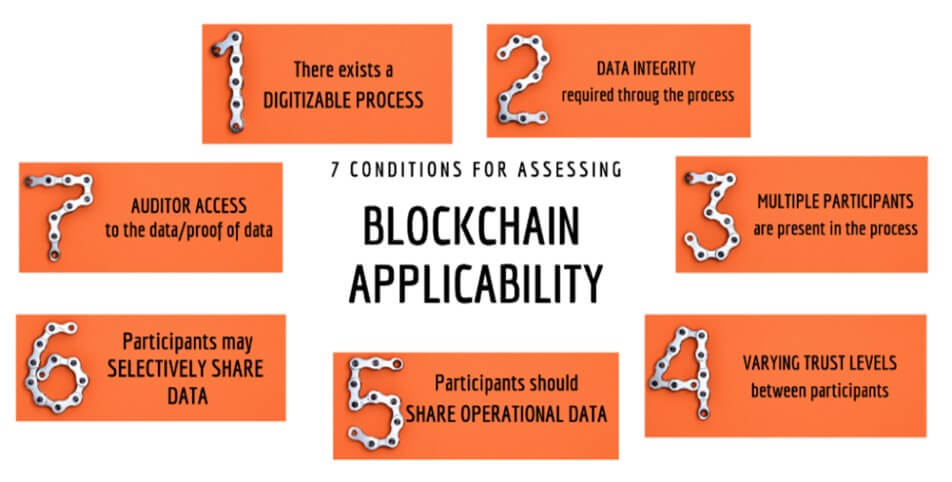
Shared services blockchain approach should be business-consulting led, with a focus on defining and achieving better business outcomes for their customers. The SSO along with the ecosystem partners should decide whether blockchain is the right technology for the identified use case. Given here is the 7-conditions feasibility assessment that can help companies test for the applicability of their blockchain use case and take the decision to go ahead with the pilot experiment. With limited effort this allows the SSO to check the viability of organization specific use cases in terms of technical feasibility, value add of the technology as well as regulatory implications.
The question is not how to use blockchain to improve services, but what services need improvement or what new services can be offered – and which technologies exist to do so. Blockchain is certainly one of the potential solutions and not the only solution.
At the end of the above assessment, all stakeholders will have clarity on why blockchain would be the right technology for the specific use cases. Envisioned benefits can include elimination of unnecessary manual work and business value, new commercial opportunities and revenue enhancement areas for all the participating entities in the ecosystem.
Phase 2 – Design – Deep Dive into details
Understanding the use case process for business implications and defining the functional requirements including the end-state of the process
Before applying blockchain to an SSO business process, there are a few decisions and actions that should be taken. The core aim is to understand the current process, its functions and how that could be mapped to blockchain functionality.
A detailed study should be carried out encompassing all pre-existing assets such as the application landscape including Enterprise Resource Planning (ERP), define the technical specifications, end-to-end business process, current issues, ‘in and out of scope’ process steps, current baseline of business/ process metrics and people deployed across the value chain including middleman costs across every sub-section of the industry.
The study should also balance the benefits of adopting blockchain with the cost of integrating this technology to existing systems such as validation workflows, business applications and the cost to address cyber security.
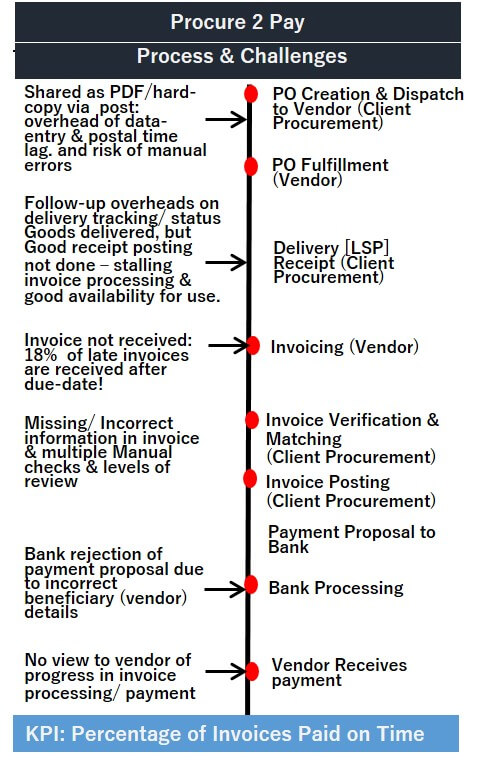
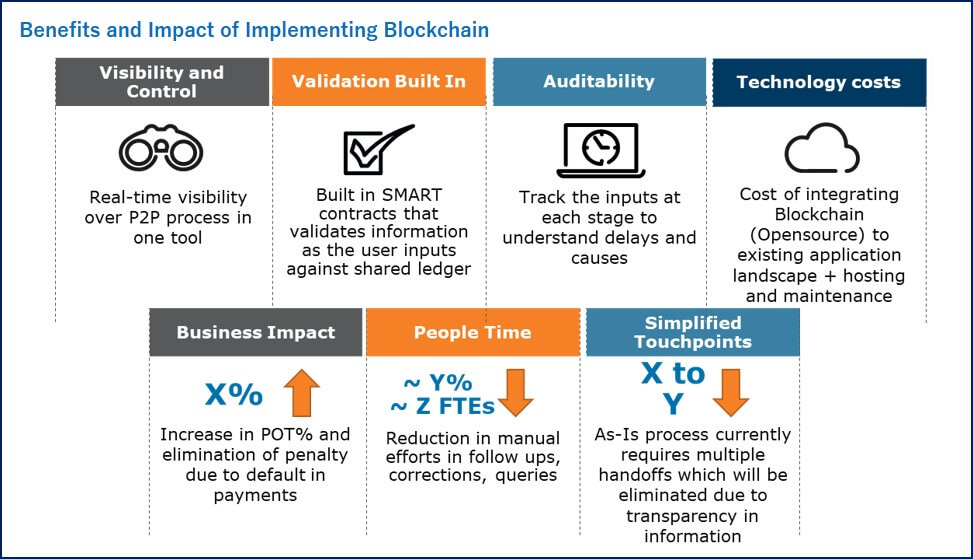
Next is the development of the to-be process with blockchain implementation and define the blockchain DLT (Distributed Ledger Technology) solution, including the information that will be shared among the participating stakeholders. A shared ledger between a customer and its ecosystem partners would significantly support and enable transactions.
The protection that blockchain offers is in the form of every organization having its own 'node', which decentralizes the peer-to-peer exchange. However, the issues of who is allowed to participate and what nodes can do in terms of observing or validating transactions needs to be addressed clearly. Given below is the illustration of the DLT and what will be shared among the ecosystem partners in a Procurement lifecycle and the end-to-end Procure to-Pay process.
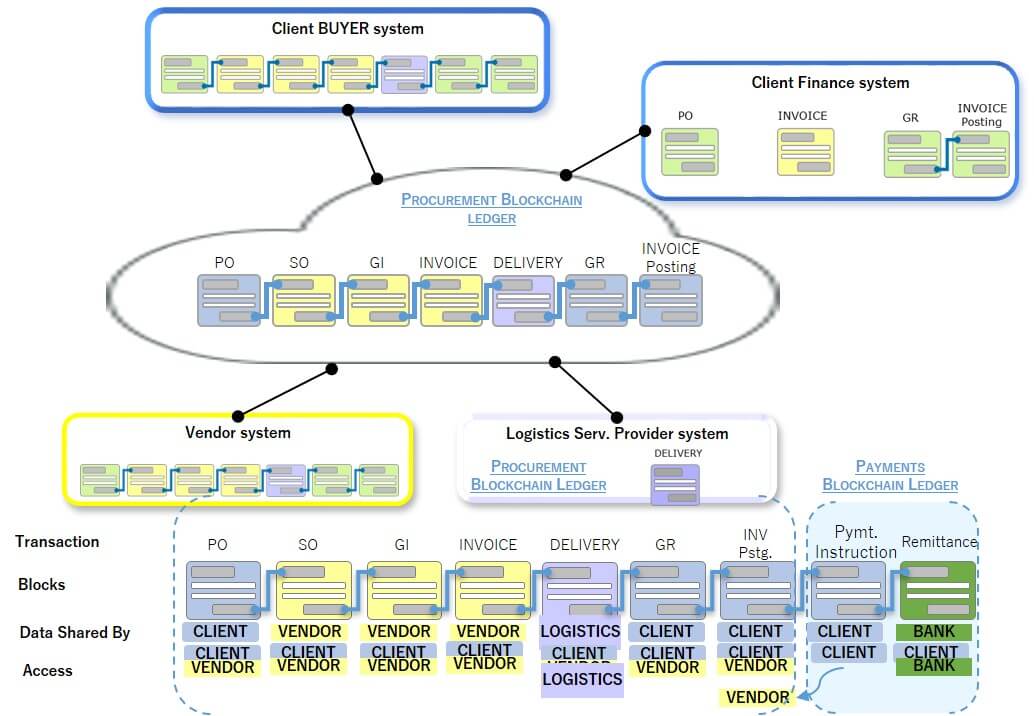
Phase 3 – Execute – Implement the Design
Building and documenting the blockchain pilot
Before commencing the Build, the stakeholders in the solution ecosystem agree and commit to a plan, each agreeing on their deliverables and timelines. It is recommended that the governance be defined – either driven by the SSO or the Organization.
Once all pre-requisite decisions and agreements are in place and the infrastructure is ready, the solution is built – both the blockchain components and their integrations with systems. The solution components are tested individually and as a whole, by technical teams and process experts.
The Build of the blockchain pilot should be complemented with supporting documentation including a user guide, a recording of the pilot in action and an extranet for stakeholders with access to all the findings and outcomes of the project.
SSOs’ advantage is that they can leverage their subject matter expertise and processing capability to take a big part in testing the Built solutions and build up a knowledge base on the working of the new solution. Subject matter experts within Shared Services control all the data that a blockchain needs to operate and is leveraged to the full extent.
The following table summarizes all the 3 phases.
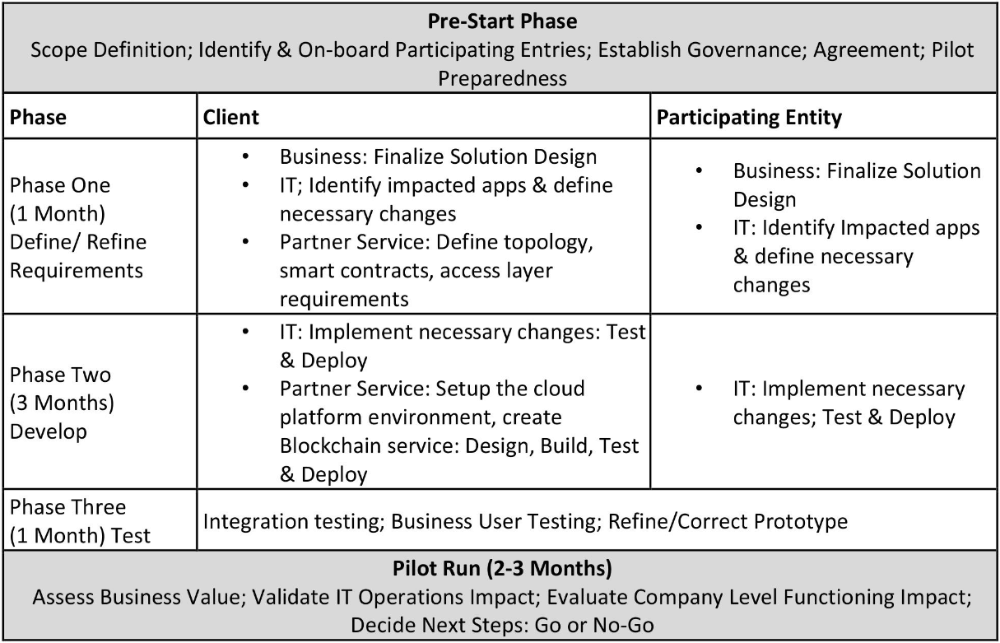
Phase 4 – Roll out
Adapt or rollout the pilot to overall landscape
Presenting, discussing and analyzing the pilot experience with the business and ecosystem partners to develop next steps and recommendations for full-fledged implementation in a controlled production environment is the conclusion of the Pilot phase.
A critical aspect of the blockchain pilot is the learning experience for the different stakeholders in the ecosystem. It is important to manage the different expectations and requirements within each individual’s own context.
Summary
Blockchain enables fast settlement of transactions, based on both parties pre-agreed acceptance, at low-cost. It’s this characteristic that is causing a lot of excitement for processing practitioner, SSOs, clients and regulators.
Any place where there is cause for validation or authentication is where blockchain can automate that need. And that is also where Shared Services can leverage its capability and scope to take a lead in - first understanding, and then rolling out, the technology. Blockchain as a technology is still in its early stages. The understanding of its integrated working is incomplete and the approach to emerging technologies is very different depending on organizational function and personality. Considerable time is needed to address the various needs and that goes beyond building a functional pilot within a few weeks or months. Its potential to disintermediate value chains and its impact on processes can only be realized if SSOs act in an agile, semi-orchestrated effort to address technical topics, wider business organizational issues and multi-party relationship topics. It is a team effort and being conscious of the aspects mentioned before will be key to plan resources accordingly and to manage timing & expectations successfully.
ABOUT THE AUTHOR

Rangaraj Sriramulu is an astute and result-oriented business leader and digital evangelist with over 25 years of work experience helping companies’ structure and implement digital strategies, grow revenue, actualize business value and enhance customer experience across multiple industry verticals in core Manufacturing, IT and BPO organizations.
Rangaraj is the Senior Vice President and Digital Leader of Business Transformation at Alorica Inc, the largest customer care provider in the world serving North America consumers with 100,000 employees and 130 sites in 15 countries. In his current role, Rangaraj is helping to create Alorica’s first Center of Excellence in India and is responsible for design, development and implementation of strategic digital solutions, which will deliver tangible value to clients, their customers and internal operations.




